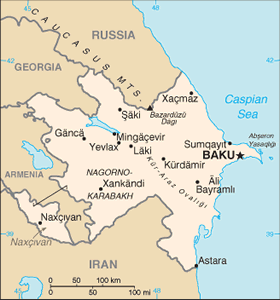The Geography of Azerbaijan
The Geography of Azerbaijan
Azerbaijani Geography
Location: Southwestern Asia, bordering the Caspian Sea, between Iran and Russia, with a small European portion north of the Caucasus range
Geographic coordinates: 40 30 N, 47 30 E
Map references: Asia
Area: total: 86,600 sq km land: 86,100 sq km water: 500 sq km note: includes the exclave of Naxcivan Autonomous Republic and the Nagorno-Karabakh region; the region's autonomy was abolished by Azerbaijani Supreme Soviet on 26 November 1991
Area - comparative: slightly smaller than Maine
Land boundaries: total: 2,013 km border countries: Armenia (with Azerbaijan-proper) 566 km, Armenia (with Azerbaijan-Naxcivan exclave) 221 km, Georgia 322 km, Iran (with Azerbaijan-proper) 432 km, Iran (with Azerbaijan-Naxcivan exclave) 179 km, Russia 284 km, Turkey 9 km
Coastline: 0 km (landlocked); note - Azerbaijan borders the Caspian Sea (713 km)
Maritime claims: none (landlocked)
Climate: dry, semiarid steppe
Terrain: large, flat Kur-Araz Ovaligi (Kura-Araks Lowland) (much of it below sea level) with Great Caucasus Mountains to the north, Qarabag Yaylasi (Karabakh Upland) in west; Baku lies on Abseron Yasaqligi (Apsheron Peninsula) that juts into Caspian Sea
Elevation extremes: lowest point: Caspian Sea -28 m highest point: Bazarduzu Dagi 4,485 m
Natural resources: petroleum, natural gas, iron ore, nonferrous metals, bauxite
Land use: arable land: 20.62% permanent crops: 2.61% other: 76.77% (2005)
Irrigated land: 14,550 sq km (2003)
Natural hazards: droughts
Environment - current issues: local scientists consider the Abseron Yasaqligi (Apsheron Peninsula) (including Baku and Sumqayit) and the Caspian Sea to be the ecologically most devastated area in the world because of severe air, soil, and water pollution; soil pollution results from oil spills, from the use of DDT pesticide, and from toxic defoliants used in the production of cotton
Environment - international agreements: party to: Air Pollution, Biodiversity, Climate Change, Climate Change-Kyoto Protocol, Desertification, Endangered Species, Hazardous Wastes, Marine Dumping, Ozone Layer Protection, Ship Pollution, Wetlands signed, but not ratified: none of the selected agreements
Geography - note: both the main area of the country and the Naxcivan exclave are landlocked


